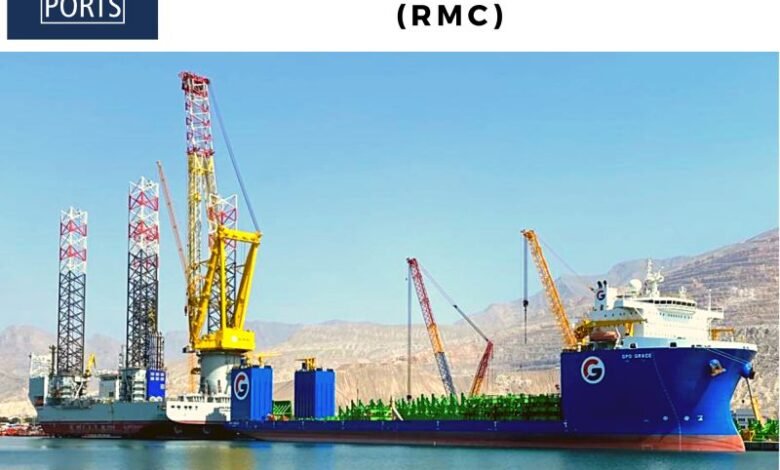
RAK Port Infrastructure: Strategic Blueprint for Maritime Excellence
RAK port system’s US$1 billion Saqr 2.0 project revolutionizes regional trade dynamics through ambitious greenfield development. Saqr Port, the largest bulk cargo handling port in the Middle East and Africa, leads a network that processes over 100 million tons of cargo each year. This maritime hub substantially advances UAE’s port infrastructure capabilities.
Saqr 2.0’s design features impressive deep-water berths that reach depths of 18 meters and can accommodate Capesize vessels. RAK ports’ capacity will grow with 6-10 new berths added to RAK Saqr port and RAK Maritime City’s existing 47 berths. The expansion taps into the full potential of approximately 5 million square meters of freezone land that offers direct quayside access.
The project goes beyond conventional port operations by including an 8-million-square-meter free zone and a state-of-the-art green ship recycling facility. Al-Jazeera shipyard’s relocation to Saqr 2.0 will centralize operations while expanding its capabilities. The facility will repair luxury yachts and provide environmentally conscious recycling services. RAK ports’ complete infrastructure blueprint establishes it as an emerging powerhouse in global maritime logistics and trade.
Deepwater Infrastructure and Freezone Integration
Saqr Port’s new infrastructure includes state-of-the-art deep-water berths with an impressive 18-meter draft capability. This depth sets a new standard in the region, as other UAE facilities max out at 15 meters. The port can now handle Cape-size vessels, which is a big deal as it means better maritime capabilities and global competitiveness.
The port expanded its capacity step by step. It started with one deep-water berth and added a second in March 2019. These engineering upgrades raised Saqr Port’s yearly handling capacity from 55 million tons to about 100 million tons. The port has become one of the Middle East’s leading bulk-handling facilities.
RAK Ports made history in January 2020 by introducing the Dynamic Under Keel Clearance System (DUKC®). This was the first time this advanced digital technology appeared in the MENA region. The system proved its worth quickly. In its first 23 months, it increased average sailing draft by 0.67 meters and cut CO2 emissions by 100,617 tons across 369 transits.
The port’s connection to RAK Maritime City Free Zone creates a smooth maritime-industrial ecosystem. This spans over 8 million square meters of premium waterfront land. The free zone, created by Emiri Decree in December 2009, gives businesses direct access to the quayside with several hundred meters of available quay wall. This makes it an exceptional gateway for industries that depend on seaborne supply chains.
Phased Development Strategy of Saqr 2.0
Image Source: Heavy Lift & Project Forwarding International
The Saqr 2.0 development follows a well-laid-out three-phase plan that will improve the port’s operational capacity step by step. The first phase will start operations in 2027 when the first basin opens. This phase will add 6-10 new berths to Saqr Port and RAK Maritime City’s existing 47 berths. The port’s cargo handling capacity will grow by 50 million tons yearly once Phase 1 is running, reaching a total of 150 million tons per year.
The second phase completion is set for 2030. The port’s capabilities will expand with deep-water berths that reach depths of 17-18 meters. RAK Ports will then welcome larger vessels that cannot dock there now.
The third phase takes a more adaptable approach into the 2030s. Planning documents show this final stage focuses on meeting future customer needs. The freezone might grow from 5 million square meters to about 12-14 million square meters.
RAK Ports will grow from its current 60 berths to 72 berths in just the first phase of this development. This step-by-step strategy helps the port respond to changing market needs and keeps its vital role in the industrial supply chain across the Arabian Peninsula and beyond.
Strategic Positioning and Global Trade Access
Image Source: Alamy
RAK Ports serves as a major international maritime trading hub near the Strait of Hormuz, linking the Middle East, Africa, and the Indian subcontinent. The port group’s location at the entrance to the Arabian Gulf sits along some of the world’s busiest shipping lanes. This strategic position provides smooth access to major maritime routes and optimizes global trade operations.
Saqr Port has become the largest bulk port in the Middle East and North Africa region, handling over 1,140 vessel calls in 2022 and moving more than 60 million tons of cargo annually. The port’s exceptional capacity makes it a vital supply chain link for thousands of companies worldwide.
The port authority has invested over AED 917.99 million in infrastructure improvements. Dynamic Under Keel Clearance technology now allows ships to load more cargo weight safely. This technology takes advantage of Gulf tidal ranges and reduces the overall carbon footprint.
RAK Ports has focused on detailed digitization programs that use integrated systems instead of standalone solutions. A state-of-the-art Port Operations System works with a single-window Port Community System. This integration streamlines all interactions with customs, immigration, and documentation processes.
The UAE’s maritime strategy now includes 106 ports across 78 countries worldwide. RAK Ports plays a key role in making the Emirates a crucial logistics hub that connects Eastern and Western markets.
RAK Port’s Saqr 2.0 project marks a defining moment for maritime infrastructure in the Middle East and Africa. The $1 billion development shows evidence of smart planning that will expand the port’s current 100 million tons annual cargo handling capacity. The new deep-water berths reaching 18 meters will welcome Capesize vessels, making RAK Ports a leading maritime facility in the region.
The project team has arranged a three-phase implementation plan that supports growth while operations continue smoothly. The first phase will launch in 2027. It adds 6-10 new berths and increases handling capacity by 50 million tons yearly. The fully operational port will handle 150 million tons annually, making it vital to global supply chains.
RAK Ports’ location near the Strait of Hormuz makes it crucial for trade networks linking Asia, Africa, and the Middle East. The port uses innovative technology like the Dynamic Under Keel Clearance System. This system improves operations and helps the environment, as shown by the 100,617-ton drop in CO2 emissions since its original implementation.
The port does more than standard operations. It connects to an 8-million-square-meter free zone, creating a complete maritime-industrial ecosystem. This connection between port infrastructure and industrial growth makes RAK Ports a full trade gateway instead of just a shipping point.
The Saqr 2.0 project shows how smart infrastructure investment can change regional trade patterns. Through careful planning, new technology, and physical expansion, RAK Ports has become a rising force in global maritime logistics. The port stands ready to meet international trade needs for decades ahead.




